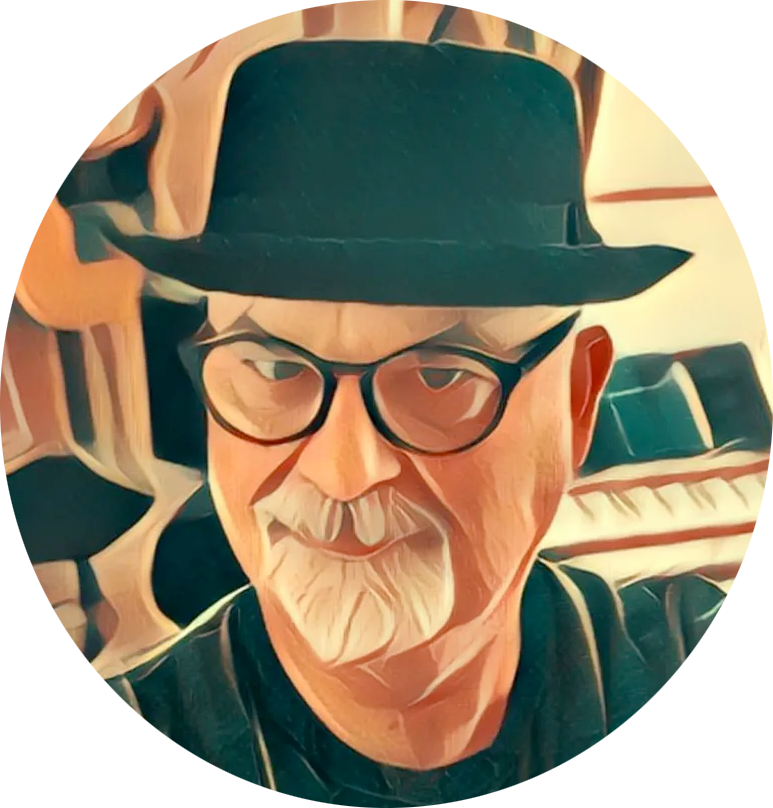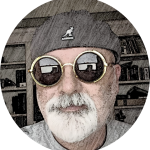

The Man
Robert Svilpa is an enigma – iconoclastic in how he tears down boundaries and beliefs held dear in music and just about anything else, mercurial in his approaches to creativity in writing and music. All while honoring influences by pushing against the tried and true – eschewing the easy path to grow in skills and incorporate everything he hears and listens to into his work.
Rob’s music has evolved from originally being loose blues-based rock into a highly regimented classic compositional progressive rock eventually coming to a place where the blues and progressive rock has incorporated all the improvisational aspects of jazz and fusion into a rock framework. Not living entirely in any one place, there’s a comfort now in allowing himself and his collaborators to let themselves contribute freely, allowing the music to take over and be elevated to the next quantum level.
So where did this guy come from?
From his teenage years, Robert has been a big fan of progressive and hard rock. Influenced by Canadian bands Rush, Max Webster, Saga, Red Rider; American bands Styx, Kansas, Boston, Weather Report, Return to Forever, Al di Meola, Synergy and others, as well as the classic British aesthetic progressive bands Yes, Genesis, King Crimson, Van der Graaf Generator, Mike Oldfield, Alan Parsons’ Project, ELP, and the like. It is easy to hear Alex Lifeson, Tom Scholz, Tommy Shaw, David Gilmour, Mike Oldfield, Robert Fripp, Steve Hackett and Steve Howe influences in Robert’s guitar work – melodic with a distinctive edge and dissonance, a love for exotic scales, fluid lines that don’t rely on blues shapes and pentatonics. Keyboard work of Tony Banks, Dennis de Young, Keith Emerson, Rick Wakeman, Geoff Downes, Mark Kelly, Mike Oldfield and Jim Gilmour strongly implied in the compositions and lead lines. Geddy Lee, Chris Squire, Mike Rutherford, Tony Levin form the foundation for Robert’s bass lines, and a combination of Neil Peart, Bill Bruford, Phil Collins and any of the Frank Zappa drummers inform Robert’s rhythmic sensibilities.
Robert spent the first half of his life honing his skills playing cover songs solo and in tribute bands, doing commercial session guitar/keyboard work both in Toronto and London, Ontario Canada, producing independent bands and artists and contributing production and mixing skills to local promotional releases that were featured and in rotation across Canada on campus radio and on the CBC (CHRW London Underground III, CHRW Jazz & Beyond). All highly influential and impactful, but except for a single piece of music released on Jazz and Beyond (“I have this wicked headache”) remained anonymous from the standpoint of any specific work of Robert’s being showcased to that point.
Experimenting with Master Track Pro 4.0 and audio recording software that became Sony’s Sound Forge – Robert wrote, recorded and mixed his first CD release “Onion”. It was an extremely limited release that was given to friends and family on CD-r and included some early versions of music that would eventually be re-recorded and re-contextualized on later releases.
This changed in 2002 when working as a software engineer with Microsoft, Robert had the opportunity to support and work with Karl (Charlie) Steinberg and the developers of Cubase/Nuendo. Through an effort by Microsoft to remediate serious security issues with Windows by updating a key component in the core OS (C++ runtime library) and requiring application developer partners to upgrade to this component, Robert met with the team on a weekly basis to provide developer support facilitating quicker integration and help improve performance of their application. Through this effort, in 2004 Cubase SX 3.0 was released – the first Digital Audio Workstation whose performance and power finally matched the software that had existed in the Apple ecosystem for almost a decade. This opened up desktop audio recording and production to a far wider group, enabling true access to pro quality releases for millions of people without the need for expensive studio recording time.
Part of working with Steinberg was needing to be one of the Alpha and Beta testers of the Cubase product – and this resulted in a lot of new material being written as part of his job, recorded and produced something that ended up becoming his second full-length release “The Sound of Thoughts” as part of a validation effort proving the Cubase/Windows platform as being ready for prime time. The album was released in April of 2006, with Microsoft recognizing and lauding the album internally as an important moment in Windows history, using it in promotional efforts externally as proof positive of Windows true arrival into the multimedia productivity area.
The album also received great recognition in online progressive rock forums – comparing it favorably to releases by bands such as Spock’s Beard, IQ, Arena, etc… As a purely independent offering, it sold over 1000 copies with Robert spending significant energy licking stamps and stuffing envelopes, shipping CDs around the world and really discovering his musical value at this time. This album is now available through Melodic Revolution Records in a remastered release version.
The follow-up “A fine line between…” arrived in 2009 – again very well-reviewed but a significantly darker album from a subject matter perspective meant that it wasn’t what most people expected. Robert dove into the subject of mental health and depression, with music and lyrics that highlighted the struggle of fictional character Ben, who experienced abuse during childhood and it affected him throughout his life. Production was vastly improved with it being the first time Robert worked with direct collaborators and outside session musicians (his band Paraesthesia were Paul Harrington and Mark Parris, while drummers Nick D’Virgilio, Andy Edwards, and Zsolt Galantai provided their portion of the rhythm section remotely). But with the onset of the Great Recession of 2009-11, manufacturing, marketing and sales suffered as economic instability affect many around the world. Some reviews which found the subject matter to be too disturbing impacted sales as well – there is a lot to be said for following one’s artistic muse and being loyal to creativity.
Additionally, Robert’s focus was pretty much entirely on his family with the birth of his 2nd son coming just weeks after this album’s release, and a third son arriving in early 2011 meant that marketing and production suffered from the split focus. The album sold very poorly, as the arrival of file-sharing sites had people choosing to download for free instead of investing directly in the CD and supporting the music.
Eventually, once things settled down, Rob revisited these two albums again in 2015 performing remix/remasters for both albums, with an additional limited release of cover tunes called Tributes 1 released digitally.
January 2019 and relocation from Seattle to the Silicon Valley – Robert began taking the musical bits and pieces he had been recording the previous three years and started to turn them into real compositions. A 5-minute piece of music that was affectionately called HTFK from 1993 and released on the “Onion” CD-r that was a staple of his live solo shows had now recaptured his attention, with a concerted focus on turning it into a long-form piece of music. Over the next three years, HTFK became Foucault’s Pendulum, going through several iterations and rewrites/revisions before arriving at the point of being a rock symphony in 6 movements. Just as the original 5-minute piece began and ended with the same guitar motif, the expanded piece used the same device. But the ultimate aim was to take the essential pieces from that original work (several keyboard arpeggios, the guitar motifs, dynamics, etc) and build out the stylistic and compositional variations to complete it.
Foucault’s Pendulum was released digitally on January 6th, 2022 – 49 minutes of music split across 6 movements. It marks the next stage in Robert’s work, as he again brought in outside help for the rhythm sections (Todd Sucherman, Marc Miller, Andy Edwards, John Jowitt, Igor Willcox, and Chris Cullman), giving them creative freedom to come up with their own parts in the hope to elevate the whole, and this is exactly what happened. Robert’s own evolution had Robert give himself the latitude to use the compositional music as a frame onto which to hang improvisational performances. Most of Robert’s guitar and keyboard work, therefore, is unedited and left in its original form as tracked – it took a lot of effort and self-discipline to not dive in and make corrections in timing and pitch but the benefit, in the end, is a very energetic and organic album that has a spontaneous, almost dangerously live sound.
The best rock albums from the 60’s through today, and in fact, the best jazz albums over the decades are the ones that captured the performance of a band playing on a tightrope without a net. The danger of players stretching their skills up to that point of almost failure injects an excitement that is impossible to capture in a quantized to the grid, pitch-corrected ProTools environment. While this album was recorded at home during the most constrained of times, having musicians of a high caliber who can run through a few takes and choose the best one (just like The Beatles and just about every other band of days gone by) keeps that energy, excitement, danger in the music – and that translates well on Foucault’s Pendulum. A true hybrid of the modern age with a vintage recording methodology keeping that vitality in the music for the listener to enjoy.
Going forward, Robert has his next album locked and loaded – vocal sessions are being lined up with more outside collaborators to finish it off, and it will be released as a stand-alone but it truly is a companion piece. “To Sleep, Perchance to Dream…” is a collection of songs that were originally intended to be part of a double CD that included Foucault’s Pendulum weaved into its fabric, but both from a focus and practical perspective they were broken into two separate releases. The two projects still have traceable connections to each other, as some musical themes are shared across the pieces on both to different effects. The audience who have both projects will hear the connection, but neither album suffers as a stand-alone project. It is just a richer experience for the loyal patron to have both.
Live performances, Robert appeared at ROSFest in Sarasota Florida in April 2022 playing in the Minstrel on the Patio program. Local artist showcases provided Robert the opportunity to expose and test drive material for future productions – an appearance at the DeLand Original Music Festival in November 2024 is scheduled.
Robert is also looking to assemble a lineup that will perform Foucault’s Pendulum and To Sleep material live.
A further recording tentatively called “Contents Under Pressure” is in the works, with the pre-production writing in the embryonic stages, with a projected release date of mid-2025 targeted.
Style of Music
Art-rock, progressive rock, prog metal, progressive jazz
Band Members
Robert Svilpa + special guests
Discography
To Sleep, Perchance to Dream – TBA – 2022
Foucault’s Pendulum – Melodic Revolution Records – CD Digital – 2022
Self released
A fine line between… – Self released – July 2009 – remix/remaster -2016
The Sound of Thoughts – April 2006 – remix/remastered – 2016
Tributes 1 – 2016
Onion – 1999 (out of print)
Other Projects/Affiliations:
HTFK – Fanshawe College MIA Student Compilation – 1996
CHRW-FM Jazz & Beyond (Various Artists) – 1996 MCA Canada (out of print)
CHRW London Underground Three (Various Artists) – 1995 (out of print)
Scratching Post (demo) – 1995
Frankenstein Five (Not on Label) – 1994
Frank Perry (self-released) – 1994
I have this wicked headache… – CHRW-FM Jazz & Beyond (1993)
Licorice Fix (demo) – 1993
Robert Svilpa Online
Bandcamp: https://robertsvilpa.bandcamp.com
Facebook: https://www.facebook.com/rsvilpamusic
YouTube: https://www.youtube.com/c/RobSvilpa
Instagram: https://www.instagram.com/robertsvilpa/
